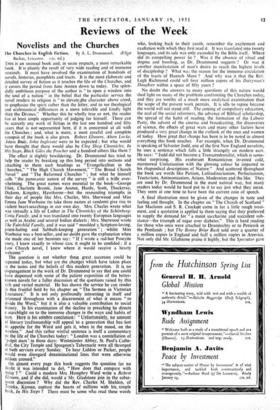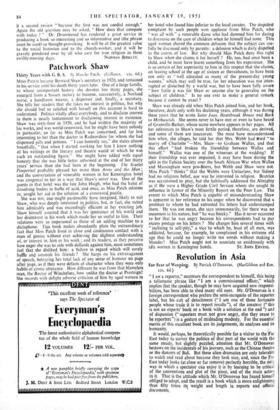Reviews of
the Week
Novelists and the Churches
The Churches in English Fiction. 1.3) A. L. Drummond. (Edgar Backus, Leicester. 125. 6d.)
THIS is an unusual book and, in some respects, a most remarkable book. It is plainly the result of very wide reading and of immense research. It must have involved the examination of hundreds of novels, histories, pamphlets and tracts. It is the most elaborate and detailed survey of fiction as it touches the life of the Churches, and it covers the period from Jane Austen down to today. The splen- didly ambitious purpose of the author is " to open a window into the soul of a nation " in the belief that the particular service the novel renders to religion is " to elevate/tithe character above creed, to emphasise the spirit rather than the leiter, and to see theological and ecclesiastical differences in a more tolerable and kindly light than the Divines." Whether this be wholly true or not, the reader has at least ample opportunity of judging for himself. There can be scarcely any work of fiction in the last one hundred and fifty years that is not.lepresented here, if it is concerned at all with the Churches ; and, what is more, a most careful and complete synopsis of the book is also given. Robert Elstnere, Alton Locke, Adam Bede. John Inglesant were to be expected ; but who would have thought that there would also be Clog Shop Chronicles, In his Steps, Black Giles the Poacher and a hundred others like them ?
The effect is slightly bewildering. Dr. Drummond has tried to help the reader by breaking up this long period into sections and attaching to them such headings as " Evangelicalism in the Churches," " The High Church Movement," "The Broad Church Novel " and "The Reformed Churches " ; but what he himself calls "the panoramic nature of the survey " is still a trifle over- whelming. The great names were essential to the book—George Eliot, Charlotte Bronte, Jane Austen, Hardy, Scott, Thackeray, Dickens, Kingsley, Hawthorne—but the resounding triumphs in their day of people like Mrs. Charles, Mrs. Sherwood and Miss Emma Jane Worboise (to take three names at random) give rise to violent heart-searchings in our own day. Mrs. Charles wrote what was virtually a life of Luther in The Chronicles of the Schiinberg- Cotta Family, and it was translated into twenty European languages as well as.Arabic and several Indian dialects ; Mrs. Sherwood wrote The Fairchild Family, and it was said " moulded a Scripture-loving, priest-hating and Sabbath-keeping generation " ; whilst Miss Worboise was a best-seller, and no doubt gave the explanation when she made one of her heroines say: "If I wrote a red-hot Puseyite story, I knew exactly to whose care it ought to be confided ; if a Low Church novel, I knew where it would receive a hearty welcome."
The question is not whether these great successes could be repeated today, but what are the changes'which have taken place in the tastes and the beliefs of this modern generation. It is, no disparagement to the work of Dr. Drummond to say that one could have dispensed with some of the patient exposition of the better- known novels for a fuller discussion of the questions raised by this rich and varied material. He has shown the service he can render in this fruitful field by his chapter on "The Sermon in Victorian Literature." It is not only profoundly interesting in itself and informed throughout with a discernment of what it means " to divide the Word," but it is also a valuable contribution to social history. In his examination of the decline in preaching he directs a searchlight on to the immense changes in the ways and habits of
men. Here is his sombre conclusion: "Unfortunately, no amount
of literary craftsmanship will appeal to a generation that has-lost its appetite for the Word and gets it, when in the mood, on the wireless." And this rather wistful sentence is itself a commentary on the life of the Churches today: " London was a constellation of 'pulpit stars' in those days: Westminster Abbey, St. Paul's Cathe- dral, the City Temple and Spurgeon's Tabernacle were all thronged at both services every Sunday. To hear Liddon or Parker, people would even disregard denominational lines that were otherwise seldom crossed."
On almost every page this book suggests the question (as no doubt it was intended to do), " How does that compare with today ? " Could a modern Mrs. Humphry Ward write a Robert Elsmere, and if she did, would a Mr. Gladstone join in the subse- quent discussion ? Why did the Rev. Charles M. Sheldon, of Topeka, Kansas, capture the hearts of millions with his, simple book, In His Steps ? There must be some who read these words who, looking back to their youth, remember the excitement and exaltation with which they first read it. It was translated into twenty languages, and its sale was only exceeded by the Bible itself, Where did its compelling power lie ? Was it the absence of ritual and dogma and humbug, as Dr. Drummond suggests ? Or was it another manifestation of man's desire to reach the highest levels of discipleship ? What was the reason for the immense circulation of the tracts of Hannah More ? And why was it that the Rev. Legh Richmond could sell four million copies of his Dairyman's Daughter within a space of fifty years ?
No doubt the answers to many questions of this nature would shed light on many of the problems confronting the Churches today, and they are worthy of a much more analytical examination than the scope of the present work permits. It is idle to repine because the world will not stand still. The coming of compulsory education, the zeal of the social reformers, the advance of Biblical scholarship, the spread of the habit of reading, the formation of the Labour Party, the advent of the cinema and broadcasting, the discoveries of science, the effects of great wars and many other factors have produced a very great change in the outlook of the men and women of today. How great that change has been is to be noted in almost everything this 'book touches. For example, when.Dr. Drummond is speaking of Sylvester Judd, one of the first New England novelists, he uses a sentence which falls a little strangely on modern ears. He says: " Judd did not become a Transcendentalist, which is some- what surprising. His exuberant Romanticism invested cold, marmoreal Unitarianism with the glowing colour he imparted to his rhapsodical descriptions of Nature." And scattered throughout the book are words like Pietism, Latitudinarianism, Perfectionism, Tractarians, Antinomianism, Arians, Modernism and the like. They are used by Dr. Drummond in the most natural way, but many readers today would be hard put to it to say just what they mean. They seem at one time to have been the current coin of speech.
A final illustration must be given of the changes in taste and feeling and thought. In the chapter on "The Church of Scotland" Ian Maclaren and S. R. Crockett come in for a little rough treat- ment, and a quotation is applied to them saying that they preferred to supply the demand for " a moist saccharine and succulent sub- stance—the triumph of sugar over diabetes." This is hard reading for those who once were attached to Drumtochty or to Penicuik in the Pentlands ; but The Bonny Briar Bush sold over a quarter of a million copies in England and half a million copies in America. Not only did Mr. Gladstone praise it highly, but the Spectator gave
it a second review " because the first was not cordial enough." Again the old question may be asked, " How dots that compare with today ? " Dr. Drummond has rendered a great service in producing a book so interesting and so informative and (the phrase must be used) so thought-provoking. It will be of the greatest value to the social historian and to the church-worker, and it will be gravely pondered over by all who care for true religion in these



































 Previous page
Previous page